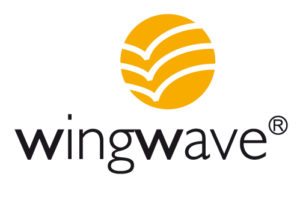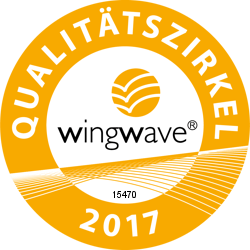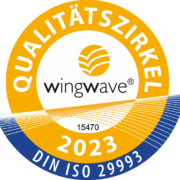
wingwave® Coaching
What is a wingwave coaching?

Bilateral hemisphere stimulation through rapid hand movements by the coach
wingwave® coaching is a performance and emotion coaching method that quickly and noticeably reduces performance stress and increases mental fitness, creativity and conflict stability in just a few sessions. The techniques used are based on the latest findings in brain research.
Three core elements of the wingwave coaching method are
- bilateral hemispheric stimulation of the brain
(i.e. visual, auditory or tactile left-right stimulation techniques) - the myostatic test

(for targeted planning of the coaching process and as an objective success control) - Specific NLC techniques - Neurolinguistic Coaching
(resource- and solution-oriented communication techniques to support the coaching process)
Procedure and mode of action of wingwave coaching
Sometimes events are so impressive, formative or stressful that they are not fully processed by the brain. These can then literally block us or trigger the stressful memories in similar situations and then trigger unpleasant stress stimuli or behavioral patterns in us again. This can even lead to anxiety, sometimes with physical symptoms. These can also be very distant events from childhood that still play out in a similar way today or trigger corresponding feelings in us.
The myostatic test (muscle feedback instrument) is used to determine the exact trigger of the stressful circumstance (stress imprinting) or the unpleasant emotions. After appropriate preparation of the coachee (client), the bilateral hemisphere stimulation begins. Here, the coachee's gaze is guided by the coach using rapid hand movements.

Coaching includes setting goals, coaching discussions and performance reviews
This seemingly simple basic intervention has the effect of triggering blocked processing mechanisms in the brain and stimulating the processing of "stress imprints" (stressful memories). We refer to this process as "awake" REM phase simulation (Rapid Eye Movement). Such REM phases (rapid eye movements during dream sleep) occur in every person, as they serve to naturally process daily experiences.
In EMDR ("Eye Movement Desensitization and Reprocessing"), where the above-mentioned stimulation technique using guided eye movements has been used since the 1980s, it has been found that this processing can also be stimulated while the patient is awake.
wingwave often helps the coachee to reduce the stressful symptoms of stress and irritation in just 3 to 5 sessions. These can be stressful thoughts, unpleasant memories and experiences or even blocking emotions and beliefs (e.g. own attitude and belief patterns), which are processed and changed with wingwave. Coachees therefore often report an increase in conflict stability, mental fitness, better performance and more creativity.
Explanatory video on wingwave coaching
History of the development of wingwave coaching
At the end of the 1980s, various coaching trainers and therapists in the USA were working on the use of "waking REM phases" for the emotional regulation of impairing stress memories. The American psychotherapist Francine Shapiro developed the method known today as EMDR for the treatment of post-traumatic stress.
Bilateral hemisphere stimulation in wingwave coaching was borrowed from EMDR. Translated, EMDR stands for the desensitization and processing of trauma-related disorders through eye movements. EMDR is recognized as a scientifically based psychotherapy method, as the effectiveness of this technique has been proven by numerous studies.

wingwave is a globally protected and recognized short-term coaching concept
The short-term coaching method "wingwave" was developed on the basis of the very good treatment successes already achieved with EMDR techniques - including up to 80-90% for post-traumatic stress disorder, anxiety and other stress response patterns. Enormous successes and the same positive changes have also been achieved and proven with wingwave in mentally and physically healthy people.
wingwave is a protected method and is used successfully today in business and in everyday personal life, in competitive sport, in education and didactics, in the health sector and in artistic circles.
As with all coaching, wingwave coaching includes a target agreement, coaching discussions and performance reviews.
Who is wingwave coaching suitable for?
wingwave coaching is suitable for all people in a normal, healthy mental and physical condition. This means that mental stability and resilience are a prerequisite, as is usually the case in coaching, because wingwave is not psychotherapy and cannot replace it.
Areas of application for wingwave coaching
- Stress imprints, negative experiences, performance stress
E.g. due to insults, conflicts, separations, defeats, financial "dry spells", etc. - Fears with or without physical symptoms
E.g.: test anxiety, speech anxiety, fear of flying, dental anxiety; after accidents or injuries - Pleasure topics
Ex: overindulgence, ravenous appetite attacks - Negative emotions and behavior patterns
Ex: Jealousy, negative spirals, repeated arguments - Resource coaching
e.g. to increase creativity, self-image coaching, performance improvement - Belief coaching
e.g. reduction of performance-limiting convictions (beliefs), euphoria traps
The basis for good coaching is sympathy and trust between coach and coachee. For this reason, I offer you a non-binding initial consultation for CHF 60 (pupils/students CHF 45).
-> To the schedule and price overview
Video examples of wingwave coaching
The following video series will give you an insight into the process and effects of wingwave coaching on various topics. These can also be helpful as preparation for your first personal wingwave session.
Turbo coaching against stress & anxiety
wingwave quality sealsl - certified since 2017



The wingwave quality seal confirms my accreditation as an ISO-certified wingwave coach by the Besser-Siegmund-Institut, as well as my commitment to keeping the method up to date with the latest scientific and research findings through ongoing training and applying it accordingly.


